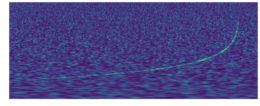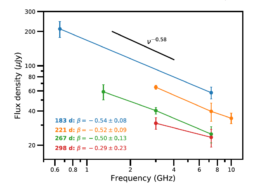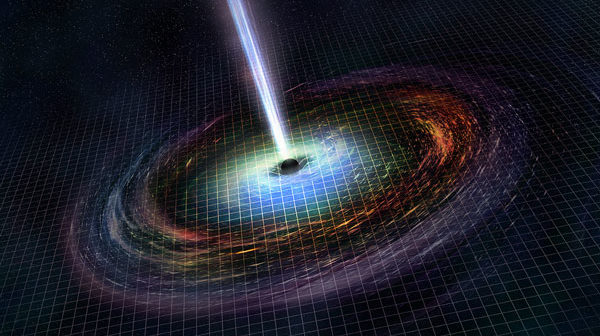Just last year, the three observatories of the Laser Interferometer Gravitational-Wave Observatory (LIGO)–Virgo Collaboration detected the gravitational-wave signature of two neutron stars colliding. What can we learn from the months of observations made since?

On 17 August, 2017, LIGO detected this “chirp” as two neutron stars spiraled inward and collided. This brief gravitational-wave blip, known as GW170817, has been followed up with months of multiwavelength observations. [LSC/Alex Nitz]
When Worlds Collide
Immediately following the detection of gravitational-wave event GW170817, teams of astronomers around the world rushed to pinpoint and characterize the electromagnetic radiation from the source.
These early observations were hugely important for validating our understanding of what happens when neutron stars collide, but the work didn’t end there; in the months that followed, repeated measurements of the flux across the electromagnetic spectrum have provided us with the tools to probe what happened in the aftermath of the merger.
These late-time observations should allow us to distinguish between two competing post-merger scenarios, in which the resultant relativistic jet either pushes past the previously ejected material surrounding the remnant (the “jet-dominated outflow” model) or fails to escape the slow-moving shroud of material (the “cocoon-dominated outflow” model) and is choked.

Radio spectral indices from 6 to 10 months post merger. Combining all the radio data gives a spectral index of -0.53. The black line shown for reference is the radio-to-X-ray spectral index measurement. [Mooley et al. 2018]
Tuning in to GW170817
In order to characterize the nature of the outflow and determine which scenario describes GW170817, a team led by Kunal Mooley (National Radio Astronomy Observatory/Caltech) analyzed the decline of GW170817’s radio emission over time. The authors combined data from multiple radio sources — MeerKAT, Very Large Array (VLA), Giant Metrewave Radio Telescope (uGMRT), and the Australia Telescope Compact Array (ATCA) — to cover the radio emission from 0.65 to 12 GHz.
After steadily rising for 5–6 months after the event, the radio emission peaked and quickly began to decline, making the transition from rising to falling in just a few weeks. The authors focused on two important features of the radio light curve: how rapidly the flux density decreases after the peak (the power-law decay index) and how “sharp” the peak of the light curve is.

Radio data used in this study. All measurements have been scaled to 3 GHz. The black line is the best-fit model. [Mooley et al. 2018]
Jet vs. Cocoon
The sharpness of the light-curve peak is dependent upon the viewing angle and the width of the jet. Based on a simple jet model, the authors find that the jet is likely very narrow (with an opening angle of less than 10°) and the viewing angle is less than 28°. Future modeling will explore the effects that structure in the jet can have on how sharply peaked the radio light curve is and further our understanding of these highly energetic collisions.
Citation
“A Strong Jet Signature in the Late-time Light Curve of GW170817,” K. P. Mooley et al 2018 ApJL 868 L11. doi:10.3847/2041-8213/aaeda7


3 Comments
Pingback: AAS Nova – New
Pingback: Daily Study Log (2019-01-24) | Study Astrophysics
Pingback: Clues from Hubble a Year After a Neutron-Star Merger